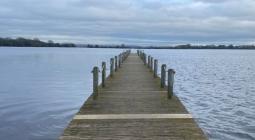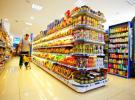SA’s toxic algal bloom is twice the size of the ACT, has killed 12,000 animals and is filling even the experts with dread
Beaches are littered with fish carcasses and scientists warn they are only ‘the tip of the iceberg’ as underwater habitats deteriorate
Anthony Rowland was heading out for a pre-dawn surf at Waitpinga Point when he felt a tickle in his throat.
He was out on the pristine water as the sun rose on South Australia’s Fleurieu peninsula, then headed back up the hill towards the car park with his friends. “Halfway up, all three of us were barking,” he says.
When they reached the car park, it was full of people coughing.
“That was the second I realised something really bad was going on,” he says.
It was Saturday, 15 March. When he went back the next day, a sickly yellow-brown foam had been whipped up along the shoreline. Dead leafy sea dragons and fish carcasses littered the shore.
Rowland – a surfer from nearby Victor Harbor who can now be described as a citizen scientist – tried to alert authorities, without success.
Then the media began reporting about the mysterious foam, and asking questions about its links to symptoms in humans and death among sea life.
It was the first time the wider population had heard of the devastating, toxic algal bloom that has left SA beaches littered with the carcasses of fish and marine animals – but it had already been brewing away beneath the waves for some time.
Estuarine ecologist Faith Coleman thinks it was killing fish as early as January.
About a week after Rowland started to tell anyone who’d listen about what was happening at Waitpinga, authorities confirmed the main algal species was Karenia mikimotoi, a type of plankton that had grown out of control. Experts say other algae that produce toxins are likely to be in the bloom as well.
The toxins affect the gills of fish, while the bloom sucks the oxygen out of the water as it dies and decomposes, effectively suffocating marine life.
It appears in the water and on the sand as a dirty stain, and in the air as an irritant to eyes and lungs. According to records, it has killed over 12,000 animals from almost 400 species so far, but experts predict the figure is much higher.
There are dead fiddler rays, worm eels, Port Jackson sharks, crabs and puffer fish. There are starfish and scallops, sea cucumbers, wobbegongs and flatheads.
It’s not toxic to humans or other mammals but can cause adverse reactions such as coughing, throat irritation and eye inflammation.
According to state government experts, there are several “plausible” factors that triggered the deadly algae bloom.
In 2022, deadly floods hit the eastern states. That water flowed through the Murray-Darling Basin, collecting organic matter on its way. Eventually, the nutrient-rich water made its way to SA’s River Murray before oozing out into the ocean.
The next summer, there was an “upwelling” of that water, bringing it to the surface.
And then a marine heatwave began in September 2024. Sea temperatures rose to about 2.5C above normal. It was hot, dry and calm.
And the bloom grew.
It spread from the Fleurieu Peninsula, to Kangaroo Island, Yorke Peninsula, Gulf St Vincent and the Spencer Gulf. It grew to 4,500 sq kms – almost double the size of the ACT – and as deep as 20m.
In June it infiltrated the Coorong, a delicately balanced ecosystem and Ramsar-listed wetlands, and in early July it made its way to metropolitan beaches and into the Port River, which is home to a dolphin sanctuary.
The bloom killed invertebrates and organisms that anchor seagrasses, leaving beaches near Adelaide strewn with clumps of seaweed. Nestled in those clumps are dead animals in states of decay.
Beachgoers can be seen walking between carcasses, frantically calling their dogs away from the rotting fish. It has forced oyster and mussel farms to close, and has caused huge complications for the marine tourism industry.
“People have seen what’s washed up on the shoreline, but that’s just the tip of the iceberg,” marine biologist and underwater cinematographer Stefan Andrews says.
Andrews is the co-founder of the Great Southern Reef Foundation (GSRF), which has been tracking the bloom.
“All of the habitats that these marine creatures depend on are deteriorating,” he says.
“But it’s happening underwater and it’s going unnoticed.”
Footage from his dives contrast colourful, vibrant underwater scenes from before the bloom with murky after-shots that look almost apocalyptic.
And there’s “weird” stuff going on, Andrews says.
Critters you’d normally see at night appearing during the day. Abalone sitting upside down. A brittle star – related to the starfish, but with long, spindly arms – has its middle missing, like a doughnut.
“It seems to be rotting away from the inside.”
When he looked under the kelp canopy while diving off Kangaroo Island, the invertebrates, the sponges, the sea squirts, were “all dead or dying and falling apart”.
As is always the case in the modern world, conspiracy theories have sprung up around the bloom. Some say Chinese warships caused it, others blame the desalination plant, some blame cloud seeding.
Estuarine ecologist Faith Coleman says people are desperate for answers.
“I’m spending an awful lot of time doing something I hate to do, which is myth busting, whereas I’d prefer to be concentrating on solving the problem,” she says.
She also says the contribution of the Murray floods and the upwelling were minor contributors. Overwhelmingly, she says, it was the marine heatwave.
The government and experts concede there are many unanswered questions – including when it will end. The state government says nothing can be done naturally to dilute or dissipate the bloom.
That won’t quell the rising calls for action.
The GSRF wrote to the federal government in 2023, warning of the likely impact of marine heatwaves. It wrote again in May this year, calling for a $40m, 10-year investment in a monitoring program.
It didn’t hear back.
“We need a coordinated monitoring program,” Andrews says. “So when events like marine heatwaves happen, we’re able to learn from them as they’re unfolding and gather valuable data.”
Federally, the Greens are calling for an inquiry and for it to be declared a national disaster, “just like a bushfire or a weather bomb”, SA senator Sarah Hanson-Young says.
The Greens senator adds that if it was happening anywhere else in the country, the federal government would be on it.
The state government says it’s working with commercial fishers, tourism operators and councils, and set up a reference group to report to a taskforce to discuss any updates.
A patrol vessel and remotely operated vehicles have been sent to conduct underwater observations.
It’s also asking the federal government to fund more research and recovery measures.
On Wednesday, the federal environment minister, Murray Watt, sent his department’s head of international environment, reef and ocean division, to SA to ensure he has “the best possible advice on the situation”.
Coleman, to whom everyone seems to defer as a top expert on the bloom and who previously worked on projects including dealing with the carp in the Murray, recently captured plenty of attention talking about the “sea sparkle”.
It’s different algae that can eat the Karenia – an appealing concept. But there’s not enough of the luminescent algae to make a significant difference.
The colder water and storms might be dispersing the bloom a bit, Coleman says, but more is needed to flush the gulfs or there’ll be another bloom this summer.
Restoring things such as the seagrasses and kelp forests, which work to suppress fledgling blooms and act as carbon sinks, would help, she says.
What most people agree on is that more data and more transparency is needed, and that climate change is the driving force that needs to be stopped.
Rowland, four and a half months after he started coughing in the car park, has become a citizen scientist embedded in a network of volunteers who are monitoring and logging the fish deaths on the iNaturalist app.
“Because the world’s heating up,” he says. “I just don’t feel confident that once it’s gone, it’s gone.
“For me, the writing’s on the wall.”
Cover photo: Death on the sand: fish and animal carcasses rot on Adelaide shores amid toxic algal bloom





